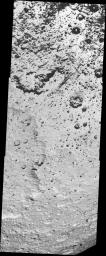Dark material has coated the low-elevation terrain and the interiors of craters in the southern portions of the quadrant on Iapetus that faces away from Saturn. This is part of the boundary region separating the dark leading and bright trailing hemispheres. The dark coating is thought to be no more than a few tens of centimeters thick (10 centimeters equals 4 inches) and, as seen here, predominately appears on the northern-facing walls of craters in the south.
Farther south, the dark splotches are less numerous and appear almost absent at the highest latitudes (near the bottom of the frame). This is a strong indicator that thermal effects play a role in the darkening process of parts of Iapetus' surface: the colder the surface, the less common is the dark terrain. As on Earth, the higher latitudes on Iapetus receive less heating by sunlight.
At left, below center, the eastern rim of a great and ancient impact basin can be seen. With a diameter of almost 500 kilometers (310 miles), it is one of the largest impact structures on Iapetus, 1,468 kilometers (912 miles) across, and in the entire Saturn system.
This monochrome view shows terrain also seen in PIA08384 but at higher resolution.
The mosaic consists of three narrow-angle camera footprints across the surface of Iapetus. This view is centered on terrain near 35.1 degrees south latitude, 218.5 degrees west longitude. Image scale is approximately 231 meters (758 feet) per pixel.
The clear spectral filter images in this mosaic were obtained with the Cassini spacecraft on Sept. 10, 2007, at a distance of approximately 40,000 kilometers (25,000 miles) from Iapetus and at a sun-Iapetus-spacecraft, or phase, angle of 31 degrees.
The Cassini-Huygens mission is a cooperative project of NASA, the European Space Agency and the Italian Space Agency. The Jet Propulsion Laboratory, a division of the California Institute of Technology in Pasadena, manages the mission for NASA's Science Mission Directorate, Washington, D.C. The Cassini orbiter and its two onboard cameras were designed, developed and assembled at JPL. The imaging operations center is based at the Space Science Institute in Boulder, Colo.
For more information about the Cassini-Huygens mission visit http://saturn.jpl.nasa.gov/home/index.cfm. The Cassini imaging team homepage is at http://ciclops.org.

 Planetary Data System
Planetary Data System












